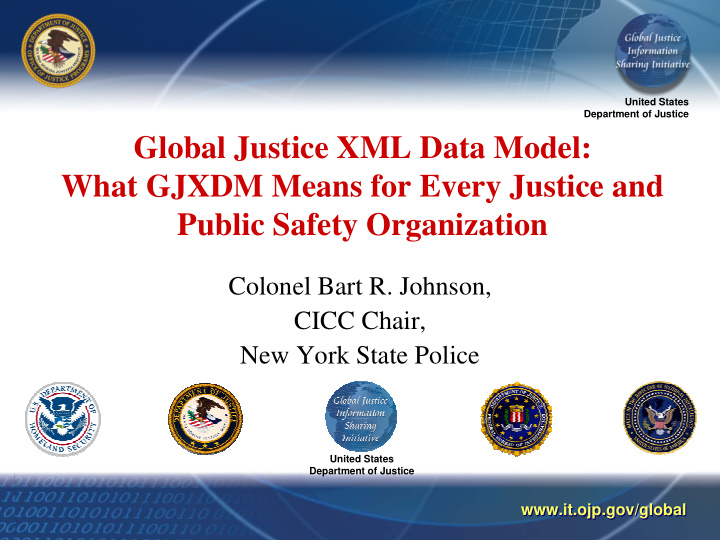



United States Department of Justice Global Justice XML Data Model: What GJXDM Means for Every Justice and Public Safety Organization Colonel Bart R. Johnson, CICC Chair, New York State Police United States Department of Justice www.it.ojp.gov/global www.it.ojp.gov/global
United States September 11, 2001 Department of Justice • 2,752 people killed • Defining moment for law enforcement agencies nationwide • Highlighted the critical need for the flow and exchange of information and intelligence • Indicators development becomes investigative focus • Added a new sense of urgency to interagency cooperation • Moved terrorism and intelligence initiatives to the forefront of many law enforcement agencies’ concerns • Strained resources of law enforcement nationwide www.it.ojp.gov/global www.it.ojp.gov/global
United States Department of Justice National Law Enforcement • 800,000 officers – 18,000 agencies • Calls for service • Criminal investigations • Specialized investigations – Narcotics – Organized crime – Money laundering – ID theft • Work 24/7 • Eyes and ears www.it.ojp.gov/global www.it.ojp.gov/global
United States Department of Justice Global Justice Information Sharing Initiative • Established in 1998, the U.S. Department of Justice’s (DOJ) Global Justice Information Sharing Initiative serves as an advisory body to the U.S. Attorney General on justice information sharing issues • Through guidance from DOJ’s Bureau of Justice Assistance, Global promotes standards-based electronic information exchange to provide the justice community with timely, accurate, complete, and accessible information in a secure and trusted environment www.it.ojp.gov/global www.it.ojp.gov/global
United States Department of Justice Global Justice Information Sharing Initiative • The Global Advisory Committee (GAC) is a “group of groups” which operates in accordance with Federal Advisory Committee Act provisions • The GAC is composed of key personnel representing 31 local, state, tribal, federal, and international justice entities • Some of the constituencies represented include law enforcement, the courts, corrections, and probation and parole www.it.ojp.gov/global www.it.ojp.gov/global
United States Department of Justice Global Advisory Committee (GAC) • The GAC membership reflects the Global tenet that the entire justice community must be involved in information exchange • Experts represent the following constituencies – Law enforcement agencies – Prosecutors, public defenders, and courts – Corrections agencies – Probation and parole departments – Victim services – Juvenile justice www.it.ojp.gov/global www.it.ojp.gov/global
United States Department of Justice Global Working Groups • Under the leadership of the GAC, five working groups examine issues of particular importance to justice information sharing. These groups include: – Global Intelligence Working Group and Criminal Intelligence Coordinating Council – Global Privacy and Information Quality Working Group – Global Infrastructure/Standards Working Group – Global Security Working Group – Global Outreach Working Group www.it.ojp.gov/global www.it.ojp.gov/global
United States Department of Justice www.it.ojp.gov – Web Site • Information regarding the Global Justice Information Sharing Initiative and its mission, members, and products can be found here www.it.ojp.gov/global www.it.ojp.gov/global
United States Department of Justice The National Criminal Intelligence Sharing Plan • Developed in 2003 as a result of the need to enhance information and intelligence development and sharing capabilities in the post-9/11 world • Former U.S. Attorney General Ashcroft; former DHS Secretary Ridge; and numerous local, state, and federal law enforcement and criminal justice agencies and organizations have endorsed the NCISP and its tenets and recommendations • Has become the de facto standard for criminal intelligence sharing among law enforcement and criminal justice agencies www.it.ojp.gov/global www.it.ojp.gov/global
United States Department of Justice Fusion Center Guidelines • Report contains 18 guidelines, recommendations, model policies, tools, and additional resources for establishing and operating fusion centers • Developed collaboratively by the U.S. Department of Justice (DOJ) and DHS • Global Initiative and Homeland Security Advisory Council were key players in the guideline development www.it.ojp.gov/global www.it.ojp.gov/global
United States Department of Justice Intelligence—Need for a Nationwide Proactive Approach • Minimize compartmentalization of data • Enhance the exchange of intelligence across jurisdictional boundaries • Elicit routine involvement of all justice agencies – Federal – State – County – Local • All-Source approach www.it.ojp.gov/global www.it.ojp.gov/global
United States Department of Justice Questions www.it.ojp.gov/global www.it.ojp.gov/global
Recommend
More recommend